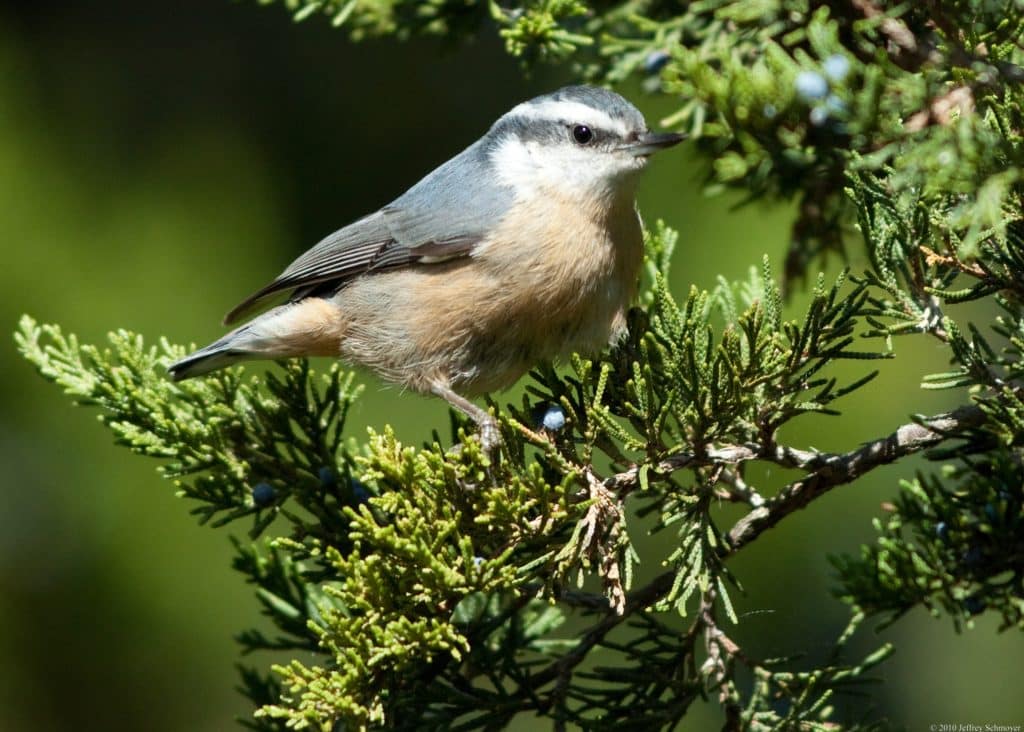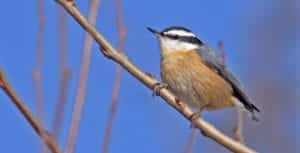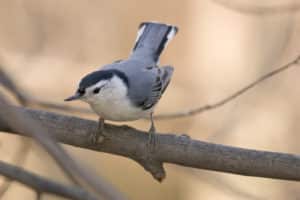
It’s not always easy to identify Maine’s most beloved birds. Maine Audubon biologists and naturalists commonly field identification questions along the lines of “is it this, or is it that?” Many species look similar from a distance, but there are some great telltale signs, both visual markers and behaviors, that can help identify species. This is an occasional series to try to help you know what you are looking at!
Two nuthatches live in the woods of Maine: White-breasted Nuthatches and Red-breasted Nuthatches (pictured above; photo by Jeff Schmoyer). They are year-round residents, but tend to become more conspicuous in the colder months, as tree trunks and branches become more visible without leaves and nuthatches spend more time visiting feeders. Red-breasted Nuthatches also move irruptively, meaning that many of them move south in search of food. It appears that this year will be one of those years in Maine, so it’s worth learning how to distinguish the two species from each other and from other similar species.
Distribution
Generally, there are more White-breasted Nuthatches in southern and coastal Maine, and at lower altitudes. Higher up and farther north, in the domain of spruce trees, one encounters increasingly more Red-breasted Nuthatches. The only time this changes is during irruptive years from fall to early spring, when Red-breasted Nuthatches move south in large numbers. Habitat-wise, they both inhabit mature woodlands and other wooded areas, with White-breasted Nuthatches more concentrated in deciduous stands, and Red-breasted Nuthatches more concentrated in coniferous stands.
Calls

Both species of nuthatch have similar call notes, but it is possible to distinguish between them with practice. They both give a call that is often written as “yank”, which is higher-pitched, more nasal, and tends to be repeated more rapidly in Red-breasted Nuthatches. Sometimes they even repeat it so fast that it almost becomes a trill; White-breasted Nuthatches tend to repeat their “yank” in clusters of twos or threes, somewhat like a sheep’s bleat. It is easier to distinguish these calls from each other in the many places in Maine where both species can be found simultaneously, but the calls can be very similar when heard separately. In any case, hearing “yanks” coming from a tree trunk is a sure sign of a nuthatch, and thankfully they are easier to distinguish visually.
Appearance

Both nuthatches have short tails, blue-gray upperparts, a white cheek, and dark cap. White-breasted Nuthatches, as their name suggests, are white underneath with rufous patches near the rump. Red-breasted Nuthatches, as their name suggests, are reddish underneath, with a dark line through the eye. White-breasted Nuthatches are larger than Red-breasted Nuthatches, and generally have no visible neck. The beaks of Red-breasted Nuthatches are somewhat more upturned but similarly pointy. Males of both species have a dark black cap, while females have a gray-blue cap similar to the color on their backs.
Similar Species
In the nonbreeding season, both nuthatches join mixed flocks foraging with other species in forests or along wooded edges. These flocks often include Black-capped Chickadees, Tufted Titmice, Brown Creepers, woodpeckers, or kinglets. Nuthatches can be distinguished from all of these species by their habit of creeping down trees head-first. Woodpeckers and Brown Creepers climb tree trunks, but always with their heads up and using their tails to balance themselves against the tree, and are black or brown on top, instead of blue-gray. Red-breasted Nuthatches can resemble kinglets and chickadees when feeding at the ends of branches, but they move less frantically, and are darker above than kinglets or chickadees. During migration and the breeding season, Black-and-White Warblers have similar feeding habits to nuthatches (creeping along tree trunks and branches), but are streaked all over, contrasting the unstreaked plumages of nuthatches.
Check out these useful posts of Commonly Misidentified Species:
Vireos: Red-eyed, Blue-headed, Philadelphia, oh my!
Diving Birds: Loons are sometimes mistaken for Mergansers, Cormorants, and even Goldeneyes
Plovers: How to tell a Killdeer from a Piping Plover and a Semi-palmated Plover.
